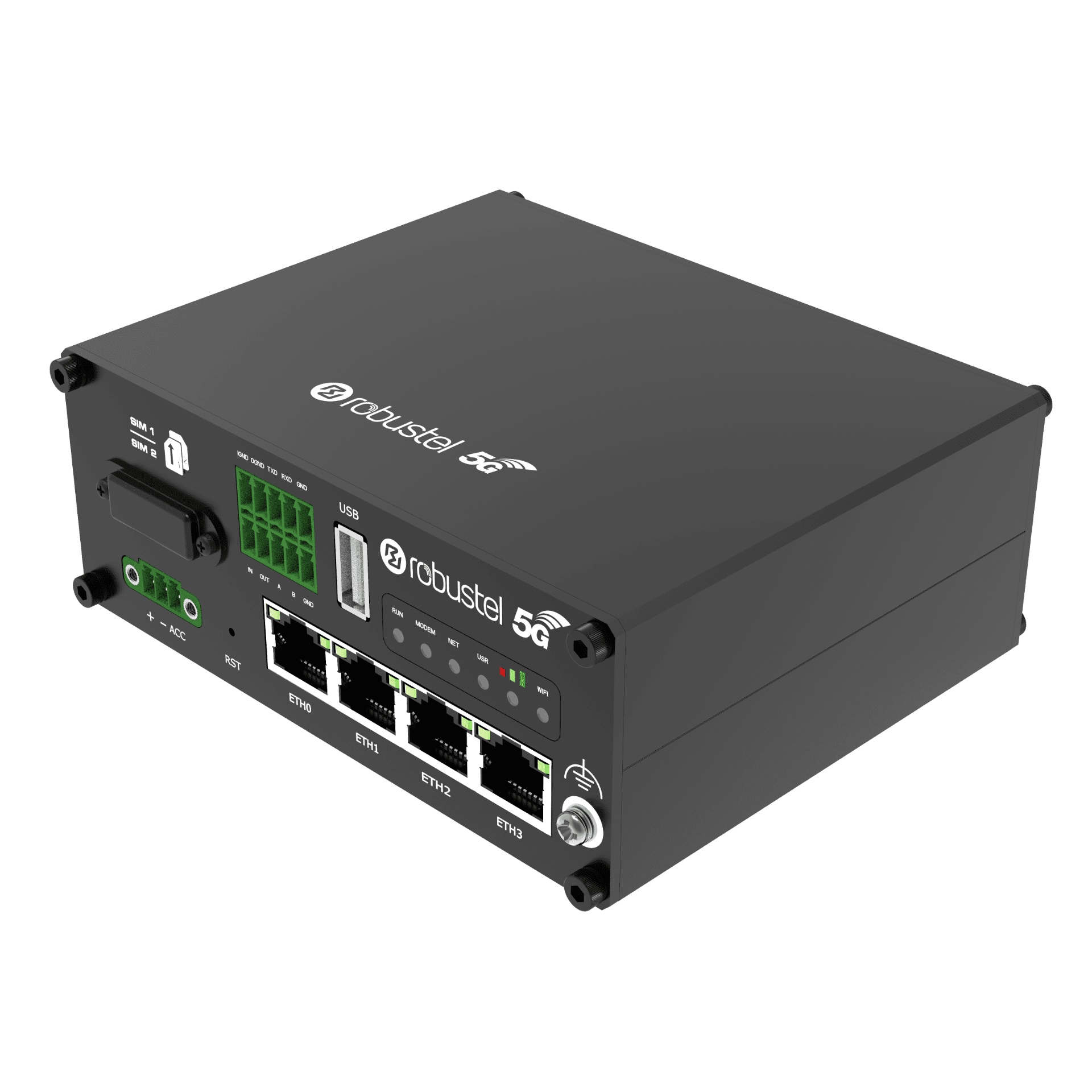Reliable 5G Connectivity for AGVs on the Factory Floor
A Robustel Application Example
Application Example – Fast Facts
Industry
Industrial IoT, Factory automation, intralogistics, automated material handling (AGVs in warehouses and production plants)
Product(s)
5G Router or Gateway; RCMS (RobustLink, RobustVPN)
Challenges
Automated Guided Vehicles (AGVs) lose connection, hesitate, or fault when they move across large production floors on shared Wi-Fi networks. That creates traffic jams, idle time, and safety concerns. Plants also struggle to monitor and control AGVs once they leave a local zone or move between network segments.
Expected Outcomes
Give every AGV a stable, factory-wide communications path over private 5G instead of relying on fragile Wi-Fi handoffs. Maintain live visibility, control, and diagnostics for every vehicle in motion across the entire site and beyond.
When your material flow depends on moving machines, network failure is production failure
AGVs are now responsible for real, high-value work: moving parts to the next station, feeding cells just-in-time, clearing finished goods. If an AGV pauses at the wrong moment because it loses its link, that delay doesn’t just slow one lane of traffic. It can stall a line, disrupt takt time, and force operators to intervene manually.
Traditional setups rely on local Wi-Fi inside the plant. As fleets scale, that model begins to crack. Coverage is uneven at the edges of the hall, congestion rises when multiple AGVs compete for bandwidth, and roaming between access points is not always fast enough for motion control. The result is instability right where you most need predictability.
The approach here replaces those ad hoc wireless links with a structured communications layer built on a Robustel 5G Industrial Router or Gateway mounted on the vehicle, talking to a private cellular network and back into RCMS. The AGV becomes reliably reachable anywhere in the facility not just in the zones where Wi-Fi behaves.
Business Challenges
Factories that adopt AGVs at scale run into a consistent set of problems:
- Handover gaps: As an AGV moves between Wi-Fi cells, there’s often a brief drop while it reassociates. Under light load this is survivable. Under full production load it causes command delays, route confusion, or emergency stops. Each pause cascades into congestion.
- Limited visibility outside the LAN: Many AGV control systems assume everything stays inside one building network. The moment a vehicle crosses into an outdoor yard, a loading bay, or a satellite warehouse, that assumption breaks. Monitoring and dispatch are suddenly blind beyond the main floor.
- Operational risk in “almost real time.”: AGVs are not just slow carts anymore. They increasingly run near people, forklifts, and other AGVs. If commands arrive late or telemetry drops out, you introduce safety and liability concerns, not just inefficiency.
- No clean way to scale: Adding more AGVs to a shared Wi-Fi environment increases RF noise, interference, and credential management overhead. Plants end up tuning SSIDs and access point power levels instead of focusing on throughput and route optimisation.
In short: once AGVs stop being a pilot and start being part of core flow, wireless becomes production infrastructure. “Good enough Wi-Fi” stops being good enough.
Solution Overview
The plant utilises a Robustel 5G Industrial Router or Gateway installed on each AGV. That gateway becomes the AGV’s communications hub.
- Direct Ethernet link from AGV controller to gateway: Each vehicle connects its navigation and control system to the gateway over Ethernet, not ad hoc Wi-Fi. That removes the flaky wireless hop between the AGV’s own brain and the radio.
- Dedicated private 5G / LTE data path: Instead of roaming across multiple access points, the gateway talks to a site-wide private cellular network. This gives consistent latency, coverage across the whole facility (and even in adjacent yards), and far fewer drops when vehicles move. It also means AGV traffic is logically segmented from guest Wi-Fi, office traffic, and operator tablets.
- Secure tunnel back to the control environment: The gateway establishes an encrypted channel from each AGV back to the plant’s AGV management layer. Commands, telemetry, and status updates are routed through that tunnel, not across open production WLANs. That helps satisfy internal security requirements and reduces the attack surface.
- RCMS for fleet visibility and live status: All gateways register into Robustel’s RCMS platform. Operations can see which AGVs are online, their signal quality, data throughput, and any communication alarms. Supervisors can also confirm that vehicles are still running approved firmware and configuration, rather than discovering version drift after a fault. RCMS effectively becomes a live map of “which vehicles are connected and behaving right now.”
- Reach beyond the factory walls: Because the uplink is cellular, the AGV can stay connected in loading bays, staging areas, or attached warehouses without custom Wi-Fi builds in every space. That extends centralised dispatch and monitoring past the main production hall.
Expected Customer Outcomes
What success looks like for the customer and the AGV supplier
For the plant / operator:
- Material flow becomes predictable. AGVs follow instructions without “stutter” caused by roaming between access points.
- Supervisors see what’s happening in real time and can intervene earlier, rather than reacting to a jammed aisle after throughput drops.
- Coverage is no longer tied to one building. Vehicles remain visible and controllable when they move into docks or buffer areas.
- Security postures improve. Traffic runs in an isolated channel instead of sharing production Wi-Fi credentials around the site.
For the systems integrator / AGV supplier:
- Support calls get cleaner. If a vehicle hesitates, you can look at link quality, latency, and last-known command through RCMS rather than guessing.
- You can prove stability. When you hand over the system, you’re not just saying “it should work.” You’re showing measured performance across the floor.
- Scaling to additional AGVs is straightforward. Each new vehicle gets the same gateway, the same profile, the same backhaul model. That’s repeatable business, not another custom RF design.
In practical terms: AGVs stop being “unreliable robots on Wi-Fi” and become trusted, networked assets in the production plan.
Featured Products
Robustel R5020 5G Router

RCMS Cloud Device Management

Talk to an Expert
If your AGVs are now part of core production flow, their network can’t be an afterthought.
Talk to us about giving each vehicle its own hardened communications path and central visibility so you scale fleets without introducing fragility.
